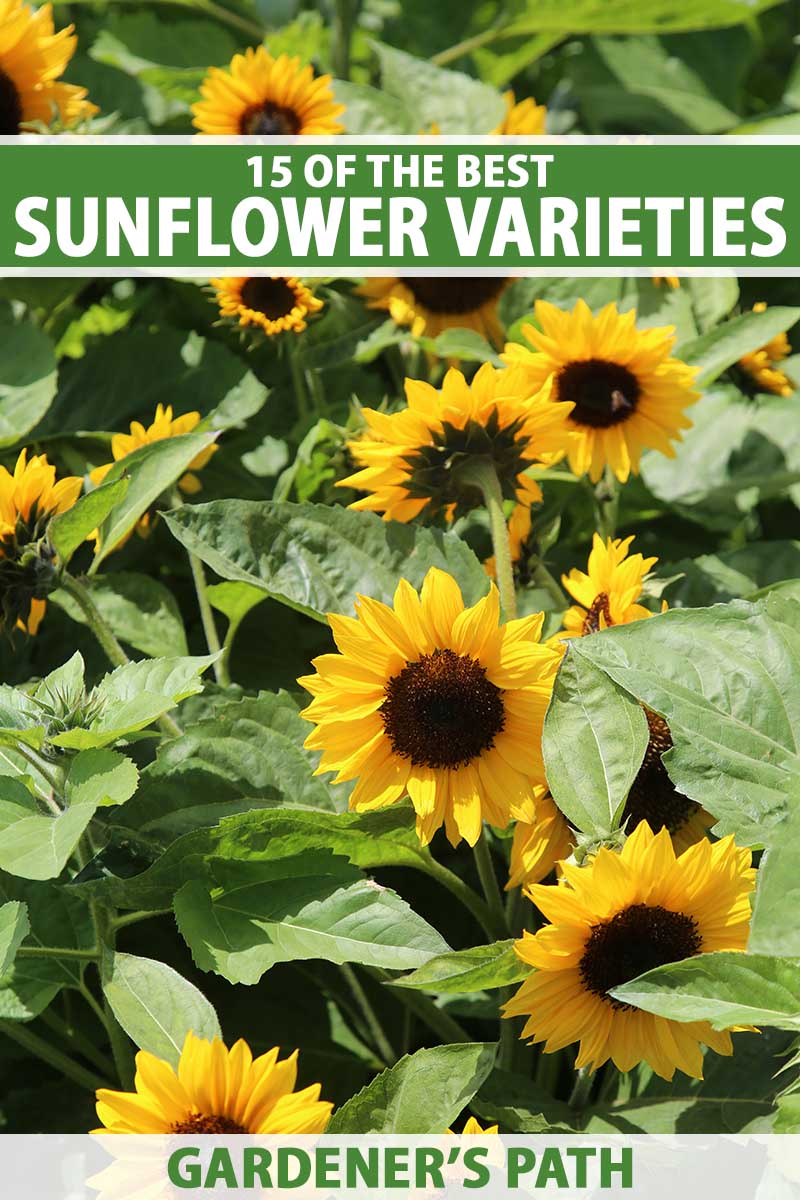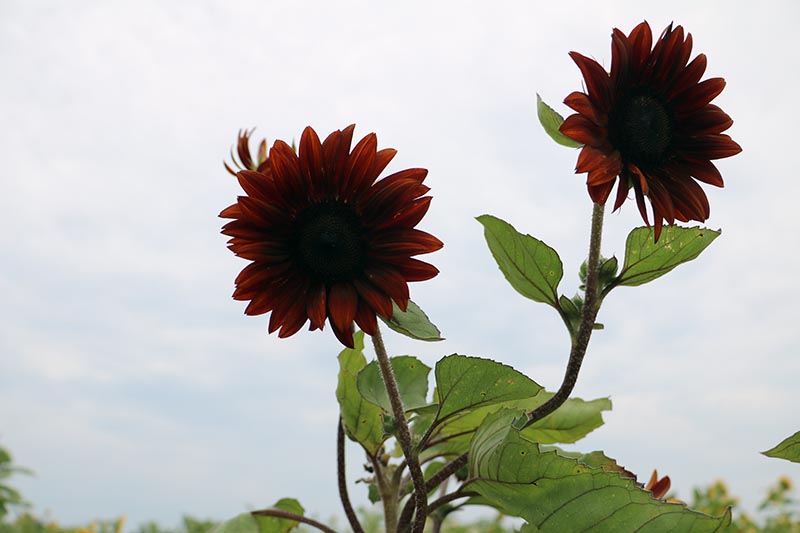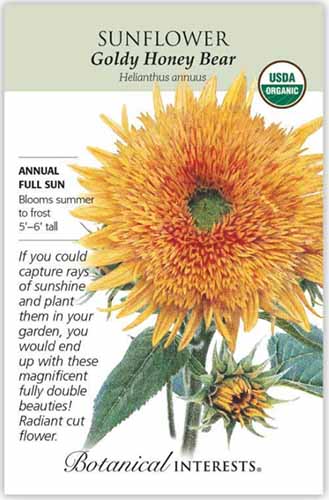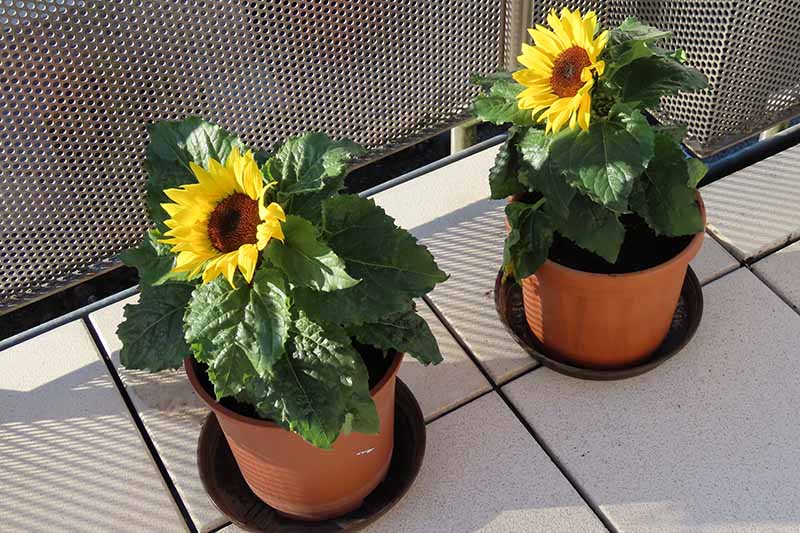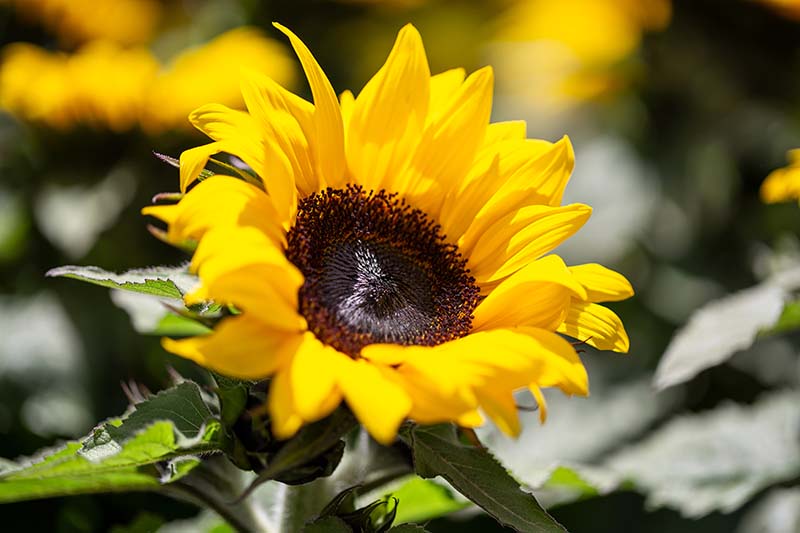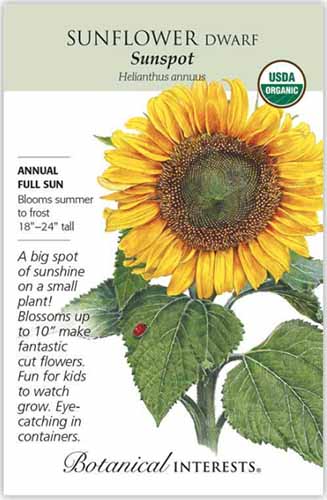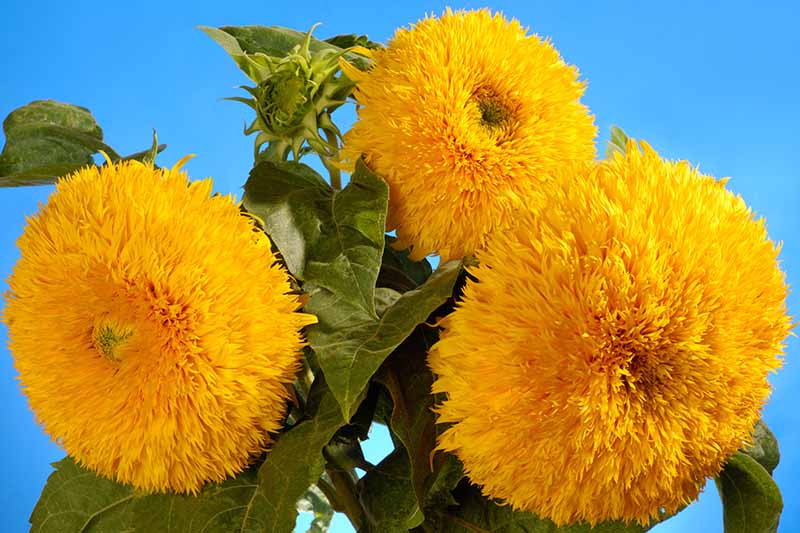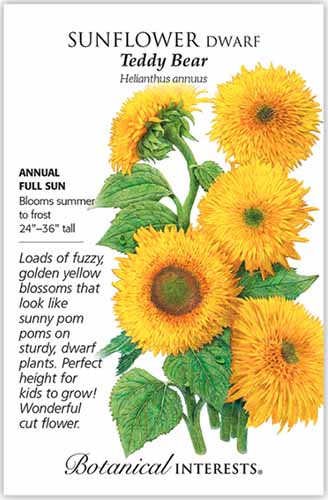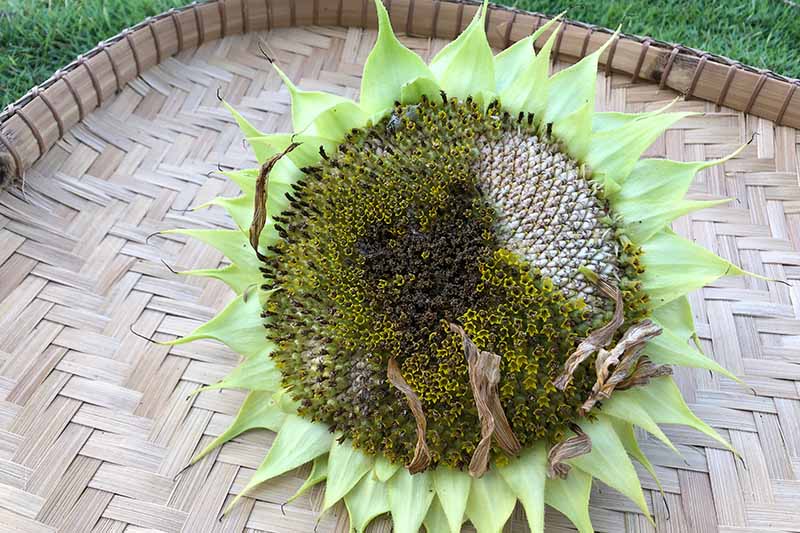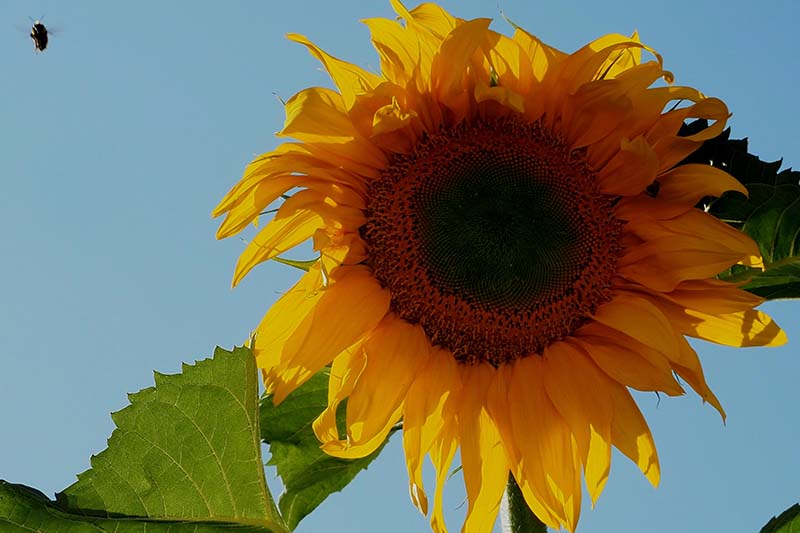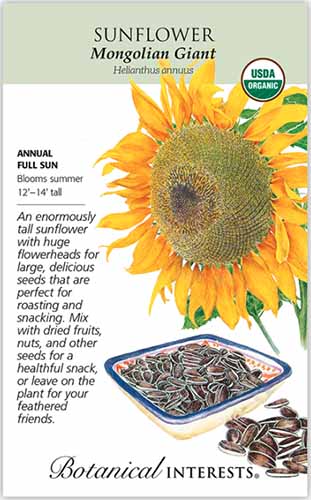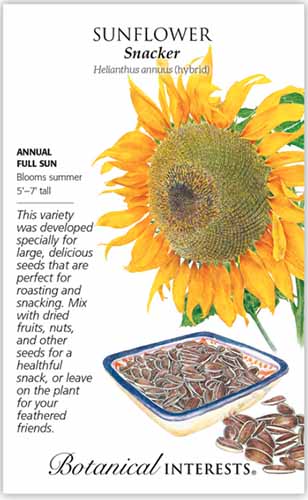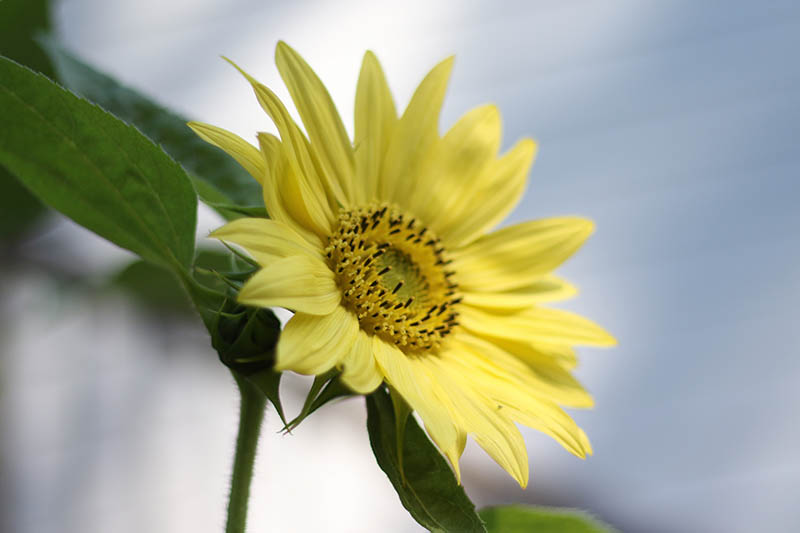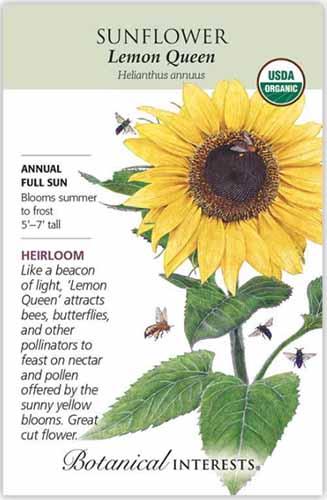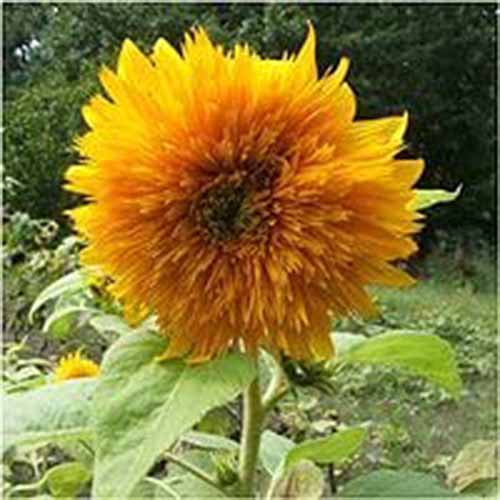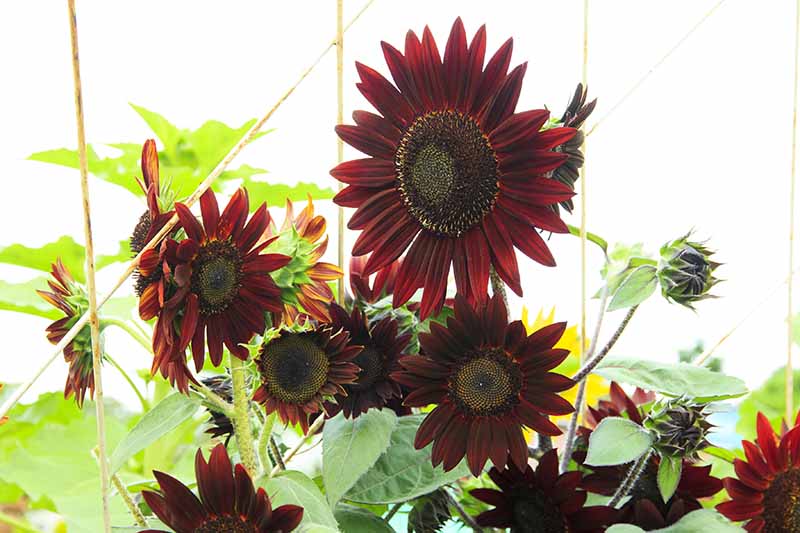I must warn you, though. When it comes to sunflowers, like I do when I see photos from my nephew’s engagement session or songbirds at my feeders, I continually pipe up with, “That’s my favorite!” And I mean what I say – until I see the next one… You, too, can unapologetically have more than one favorite among the popular cultivars of Helianthus annuus, because there is so much variety within the group. We link to vendors to help you find relevant products. If you buy from one of our links, we may earn a commission. They come in many colors, heights, and widths, and they answer a variety of gardening needs. So even with this handy roundup to help you narrow your choices, you may need to select more than one. I will help you find the best variety to start with. Further expansion of your repertoire is up to you! And I hope you don’t fault me if you ultimately choose a “favorite” from each of the categories I’ll cover. Here’s everything you’ll discover in this roundup: I’ve organized the following selections based on how big they get, how they’re used, and whether their growth habits are branching or single stem. A couple fall into more than one category, so be sure to peruse the whole list to find what you need. Some are heirloom favorites, others the latest hybrids. These are some of the best branching sunflowers to grow in your garden:
1. Autumn Beauty
If variety is the spice of your life, ‘Autumn Beauty’ might be your type of sunflower. This open-pollinated branching variety grows 60 to 80 inches tall and includes a rich assortment of fall-hued blooms, including oranges, reds, and yellows. It’s a good choice for the impatient gardeners among us, since flowering starts just 60 days from sowing. I especially like all the unique colors you get from a single pack of seeds. ‘Autumn Beauty’ Just a glimpse of the blooms will make you want to grab your sweater and something sweet that’s sprinkled with pumpkin spice… ‘Autumn Beauty’ seeds are available in various packet sizes and in bulk from Eden Brothers.
2. Chocolate
I’m not going to tell you these blooms are as tasty as their namesake, because that would be a lie. The petals and buds are edible, though, if you grow them without chemical sprays. ‘Chocolate’ has its own delicious appeal – as eye candy. It sports deeply-colored blossoms in shades of mahogany and cocoa brown. It grows four to five feet tall, and each plant produces multiple blooms that pollinators seek out. Taking 65 to 75 days to bloom from seeding, the flowers provide color in the garden after the spring annuals have faded, and before the slower-to-mature sunflowers like ‘Mammoth’ start blooming in late summer. ‘Chocolate’ In the cutting garden, the rich color of these is a wonderful complement to any cream-colored variety, like ‘Italian White,’ which you’ll read about in a minute. ‘Chocolate’ seeds are available in various packet sizes from Eden Brothers.
3. Goldy Honey Bear
I’m not sure what these gorgeous double blooms have to do with bears, but they are honey-colored, so what’s in a name? To me, the petals look like a sunset that you’d see at the beach, shooting out pointed rays of gold with rosy highlights near the pale green centers. The flowers span five to seven inches across, and bloom over a long period of time. Each plant has multiple branches, so you can expect lots of these sizable blooms from a packet of seeds, starting about 60 days after sowing. Another bonus: They have super sturdy stems, so even though they grow to five or six feet tall, there’s no staking required. ‘Golden Honey Bear’ Since they’re virtually pollenless, you can enjoy them in floral arrangements. One or two placed in a simple glass vase are so attractive that you won’t need to add more filler or greenery, which certainly appeals to low-key home decorators like me. ‘Golden Honey Bear’ seeds are available in 25-seed packets from Botanical Interests.
4. Italian White
This hardy branching variety produces a profusion of creamy blooms with dark centers. I hate to do this to you if you haven’t eaten lunch yet, but I have to share my impression that the name and color scheme of these always reminds me of Italian cream cake… The upright stalks grow to 48 to 60 inches tall. Like many old-fashioned varieties, they take a while to bloom, somewhere between 90 and 110 days. When they burst forth with bunches of four-inch, daisy-like blooms, the wait will seem worth it, especially since they’ll keep blooming for a month or more. ‘Italian White’ Cut the stems often for floral arrangements, and to encourage more blossoms. ‘Italian White’ seeds are available from Eden Brothers.
Dwarf
If you grow yours only in containers, or just want a manageable size for a flower bed, dwarf sunflowers are a popular option to choose. In some cases, they produce substantial flower heads on stems and stalks that attain a height of just 12 to 36 inches. Other dwarf varieties have petite blooms. Here are three of the best space-saving cultivars to consider:
5. Sunspot
Don’t overthink the name of this cultivar! The flowers are not blotchy or dark like the spots on the sun that Galileo and Thomas Harriot first identified more than four centuries ago. This mighty-but-tiny plant produces extra-large flower heads, on sturdy stalks that reach just 18 to 24 inches tall. It draws bees and other pollinators, too. While it’s ideal for container growing, I’d also encourage you to experiment with ‘Sunspot’ as a low-lying blooming hedge along walkways. Or, grow it in front of taller cultivars that have contrasting colors, like ‘Velvet Queen.’ Like all of its open-pollinated H. annuus relatives, ‘Sunspot’ sports edible petals – as long as you grow the plants without using chemical sprays. ‘Sunspot’ They taste just a bit bitter, like young dandelion greens, and make a pretty garnish for leafy salads or sprinkled in tiny shreds atop cakes with creamy icing. Find ‘Sunspot’ seeds in two-gram packets available at Botanical Interests.
6. Teddy Bear
With fuzzy, double-petaled, bright yellow blooms, ‘Teddy Bear’ seems kind of cuddly. And it’s also a space saver. It grows two to four feet tall, yet produces flowers that are five to six inches across. They take about 75 days from seeding to start blooming, but that flowering spree may last for five weeks. ‘Teddy Bear’ You can find ‘Teddy Bear’ seeds in one-gram packets available at Botanical Interests. Read more about growing this dwarf variety in your garden in our guide.
7. Topolino
This sweet little yellow cultivar does what the big guys do, only on a lower plane. ‘Topolino’ produces loads of bright, single-petal blossoms on plants that top out at 16 inches tall. Among popular dwarf varieties, it’s unusual because it branches out instead of growing on single-stem stalks. ‘Topolino’ The branching trait is nice in a small-size sunflower if you plan to use it to fill in annual beds in midsummer, or if you just want a variety that will look healthy and spread to the corners of a container planting. ‘Topolino’ seeds are available in packets of various sizes from Eden Brothers.
For Eating
Birds and humans alike can eat the seeds from any open-pollinated variety of H. annuus, but some home garden cultivars are particularly popular because they produce lavish amounts of meaty seeds. Some of these are beloved heirlooms, towering over the rest of the garden, with flower heads exceeding a foot in diameter. Others are more recently bred cultivars. Note that these are also the ones that are so tasty you’ll be willing to fight the squirrels for the harvest. Here are three of the best for anyone who wants to eat the seeds after the bright blooms have died back:
8. Mammoth Grey Stripe
No kidding, one little ‘Mammoth Grey Stripe’ seed produces a stalk that can grow eight to 12 feet tall! The flower head at the top will be at least 10 inches in diameter, and maybe as wide as 13 inches. This variety is also open pollinated, which means it draws bees and other pollinators and relies on them, too. To grow and enjoy this well-known cultivar, you’ll need to be able to plant it somewhere with plenty of sun and water, and where no one’s been spraying pesticides. And the statuesque stalks need support, like a fence or bamboo stakes, with enough room so you can space them at least three feet apart. Oh, and not to burst any bubbles, but please keep in mind that tending these is a long-term prospect. They take 100 to 110 days from sowing to blooming. That does not allow enough time if you are planting late this year, or have early frosts in your area. These bonus-laden babies are worth all the resources you’ll expend, though. The blooms can last for more than a month before they droop to signal harvest time is nearing. Each flower can potentially yield more than 100 seeds, and the plants are deer resistant too! Plan to cover the mature heads with netting so you won’t have to share with birds or squirrels – at least not until you place the gray-striped seeds in the feeders next winter. ‘Mammoth Grey Stripe’ Or, if you’re not worried about forlorn chickadees and cardinals, store the whole harvest to roast for your human friends. ‘Mammoth Grey Stripe’ seeds are available from Eden Brothers in various packet sizes and in bulk up to five pounds, and also in packets of organic seeds.
9. Mongolian Giant
Remember when you were a kid and sunflowers seemed so big and tall because you were so little? ‘Mongolian Giant’ has that same effect on adults. This variety is huge! The stalks grow 12 to 14 feet tall, and produce just one flower apiece. But you won’t feel cheated, because each flower head is a whopping 14 to 18 inches in diameter. That’s bigger than a dinner plate! They take about 90 days to bloom. The showy yellow flower heads may last another four to six weeks before dropping their petals, and forming giant seed heads filled with contents coveted by humans and songbirds alike. If you have the space, and they have the required attention span, growing ‘Mongolian Giant’ is a great project to try with kids. At the peak of the growing season, the stalks will gain more than an inch per day. ‘Mongolian Giant’ Some enterprising parents train these to grow as sort of a living tepee, but I prefer the simpler approach of growing several along a fence to provide a shaded play spot in the summer. ‘Mongolian Giant’ seeds are available in 12-gram packets from Botanical Interests.
10. Snacker
Not ready to tend gargantuan stalks, but you still want to enjoy a harvest of homegrown sunflower seeds at the end of the blooming season? ‘Snacker’ might be your solution! This popular hybrid is exclusive to Botanical Interests. It grows five to seven feet tall, and takes 60 to 70 days to flower. The blooms, one per stem, look much like ‘Mongolian Giant’ flowers, only they’re about half the size at just six to eight inches in diameter. Each produces up to a pound of meaty kernels, and the ripe seeds are ready about a month to six weeks after the plants bloom. ‘Snacker’ This seed-boasting variety also works as a cut flower, and can do double duty as a food provider and privacy screen. ‘Snacker’ seeds are available in six-gram packets from Botanical Interests.
Medium-Tall Types
Not seeking county fair contest-size sunflowers? Medium-statured varieties are also an option. It’s not necessary to commit to a 15-foot mammoth sunflower just to have some height for hedges, borders, or privacy fences. Sometimes the varieties that grow four to seven feet tall are just the thing. Moderately tall sunflowers are a nice choice when you want to plant a full meadow or a long row of single-stem blooms (my favorite!) that won’t require support, or not much. Those striking floral arrangements in deep vases also look great featuring varieties with tall, but not towering, stalks. If you’re not quite sure you want the mid-height types, check out the following five, and you might reconsider:
11. Lemon Queen
ABBA has their “Dancing Queen,” but gardeners get ‘Lemon Queen,’ and it’s every bit as upbeat as the disco song. Super easy to grow and extra-appealing to pollinators, ‘Lemon Queen’ attains heights of five to seven feet. It produces blooms with lemony petals and deep brown centers. It matures in 100 days, so you’ll need to be patient. But keep in mind that the buds are edible, so harvesting some of the bounty earlier is also an option. ‘Lemon Queen’ usually produces one main bloom atop the center stalk, and then smaller blooms develop on side shoots. It will keep flowering until the first frost hits. ‘Lemon Queen’ If you’re planning to eat some buds and wish to have plenty of blooms for floral arrangements as well, consider successive plantings every week or two. Stop sowing more when it’s 12 weeks before your area’s average first frost date. ‘Lemon Queen’ seeds are available in two-gram packets from Botanical Interests.
12. ProCut Bicolor
With one flower per stalk, ProCut is a series of pollenless hybrids developed for those who want to have material for floral arrangements – hence the “Pro” in the name. These are also fast, blooming just 50 to 65 days from seeding. This makes a great option if you live in an area with a short growing season, or if you’re a little late planting out. The ‘Bicolor’ variety is ablaze with sunset colors, so the three- to four-inch flower heads are striking in borders or planted alongside the mailbox, too. They’re pretty tall, reaching four to six feet before blooming, so it’s possible they’ll need staking or other support. ‘ProCut Bicolor’ Make sure to pick them right before they flower, and place the stalks in a deep vase so they don’t droop. ‘ProCut Bicolor’ is available in 500-seed packets from True Leaf Market.
13. Taiyo
One of the most popular heirloom sunflowers,‘Taiyo’ hails from Japan, and takes 12 to 14 weeks from sowing to bloom. A butterfly and bee magnet, each plant produces a single flower head about 10 inches wide. The petals are dainty, and surround striking deep orange and mahogany centers. And the plants inch up to five to seven feet before blooming. They’ll throw a fair amount of shade, so be careful with what you grow near these statuesque stunners. ‘Taiyo’ Plant ‘Taiyo’ for pollinators, cut flowers, or just to gaze at. A few are lovely, a field full of them is magnificent. ‘Taiyo’ is available in variously sized packets and in bulk up to five pounds from Eden Brothers.
14. Tall Teddy
Oops, there’s that word again. ‘Teddy Bear’ is one of my favorites among the dwarfs, and I was so happy to discover the same fluffy bloom style in a cultivar that grows six feet tall. ‘Tall Teddy’ is an appealing choice for a non-traditional sunflower meadow. Or, grow four or five against a fence panel or trellis for a privacy screen. The double blooms are glorious, a full 10 inches across. ‘Tall Teddy’ Sometimes the stalks produce multiple flowers, though the side blooms tend to be smaller than the main flower head.
15. Velvet Queen
Here’s another regal name for another splendid, free-branching sunflower. Just veering on “tall,” the four- to six-foot ‘Velvet Queen’ is a quintessential red cultivar. The flowers have pronounced jet black centers, and subtle orange highlights on the tips. This heirloom variety produces mightily over the season. It starts with a few blooms around 55 days after sowing, gains momentum for a big show a few weeks after that, and continues on for months, with the last flowers blooming just before the first frost. The flowers are usually six inches across, but can sometimes grow to almost eight inches in diameter. ‘Velvet Queen’ These plants are popular in borders and along walkways, and in floral arrangements paired with more traditional yellow-petaled varieties. Find ‘Velvet Queen’ seeds in several packet sizes or in bulk at Eden Brothers.
Take a Shine to These Sunflowers
Once you start growing sunflowers, I suspect you’ll continue, and that the process will involve lots of fun choices as you go along. You may begin with a branching variety for a flower bed border, for example, later plant a couple of giants to provide seeds for the local birds, and then gradually add pollenless varieties for flower arrangements. Or maybe you’ll stick with your original choice for decades. And that’s wonderful too! In any case, you’ll continue to discover new combinations and standout varieties worthy of consideration for as long as you continue to garden. The selection process alone can provide hours of enjoyment. Which sunflowers are growing in your garden, and which are your favorites? I’d love to hear about your choices in the comments below. And if you have questions, post them, too. If this introduction to popular varieties intrigued you, we have a wide selection of H. annuus coverage available. Check out these sunflower guides next:
How to Grow Sunflowers: A Beautiful and Tasty Addition to Your LandscapeHow to Help Sunflowers That Won’t BloomHow to Identify and Control Common Sunflower PestsTips for Growing Black Oil Sunflower in the Home Garden
